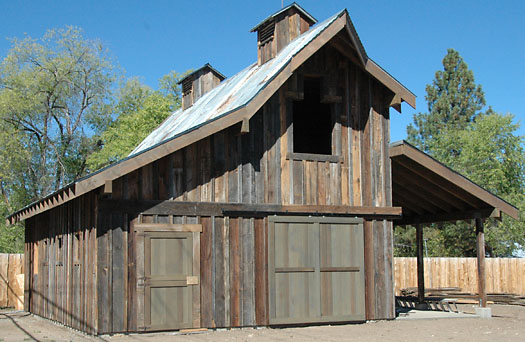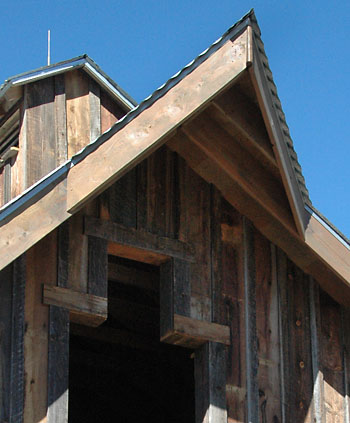home | internet service | web design | business directory | bulletin board | advertise | events calendar | contact | weather | cams

|
New Old  The siding on the new Shafer Museum barn in Winthrop came from an old homestead at the south end of Pearrygin Lake. The siding on the new Shafer Museum barn in Winthrop came from an old homestead at the south end of Pearrygin Lake.
“It’s our new old barn,” said Roxie Miller. Roxie and her husband, Carl Miller, have been spear-heading the re-design and re-construction of the 110-year-old barn that is the latest addition to the Shafer Historical Museum on Castle Avenue in Winthrop. They expect the barn to be finished in time for the museum’s opening next Memorial Day. While the barn’s exterior is mostly original materials, the interior will be fully refurbished. The old barn was used for livery and hay storage, yet the new barn will house exhibit space and offices as well as a climate-controlled archive for the museum’s collection of old newspapers, documentary materials, books and magazines, and thousands of photographs. The museum hopes to hire an intern next year to organize the archive. Once part of the Graves farm, the saltbox-style barn was recovered last year from Pearrygin Lake State Park after Park Manager Rick Lewis called Richard Hart, chair of the board for the Shafer Museum, and told him the decrepit structure was a public hazard and would have to be burned down if not removed. Hart jumped at the opportunity to salvage the old barn, and with funding from the Rose Miller family, the relocation process began. Since this April when the project began, it’s been a modern version of an old fashioned barn-raising - a community coming together for a common cause. Much of the work to dismantle, redesign, and reconstruct the barn has been donated or discounted for the museum. Barb Preston of Pinto Design in Mazama made the construction drawings based on, as she said, “the vision that Roxie and Carl had for the barn,” including the addition of two cupolas. Meanwhile, volunteers such as Jerry Pruitt have been donating their carpentry skills. To top the barn off, artist Jessica Deitz, of Winthrop will craft an original horse-design weather vane.  Eventually, an old Jackson hay fork will hang from this hay hood on the front of the barn. Eventually, an old Jackson hay fork will hang from this hay hood on the front of the barn.
Carl Miller’s favorite part of the barn may very well be the Jackson Hay Fork, a pair of large claw-like forks that will be suspended from the barn’s second-story hay hood. The forks are meant to grab loose hay from a wagon below and through a series of ropes, pulleys, and track deliver it to the hay loft. “We also have a hay sling that would be lifted full of hay straight from a wagon,” Carl said. Plans include placing a silo and workshop on the same lot after the barn is completed, according to Hart. The museum expects to recover one of the red octagonal stacked-wood silos that can still be found around the Methow Valley. A perfect example of one stands on the old Lloyd farm off Bear Creek Road. “They were made of mill ends,” Carl Miller said, referring to the discarded end-cuts from lumber mills. “It took a lot of mill ends to make a silo.” The silos typically stored corn silage, a more efficient fodder than hay for cattle during winter, Carl explained. He added that the piece of equipment on the new deck of the Duck Brand Restaurant in Winthrop is an old corn chopper and silage blower. The workshop would be used for restoring the 1923 Rickenbacker automobile, one of the museum’s more rare possessions. It would also be used for working on the engines of various pieces of equipment belonging to the museum.
The museum’s small stamp mill, which was used to crush ore, is operable, but the big stamp mill is not. “To run the big mill would probably break some windows around town,” Hart said. “It’s big.” Along with the two cabins that were relocated to the lot last year, the barn, silo and workshop will significantly complement the museum village, which includes the general store, print shop, school house, and ladies shop. However, the centerpiece of the village remains the house pioneer Guy Waring built on site in 1896, called The Castle for its prominence overlooking the town. The Shafer Museum was founded by the Shafer family, which ran the town’s general store throughout the mid-1900’s. The collection of farming equipment and assorted gadgets began during the Depression when the family allowed locals to barter and trade for goods. After Highway 20 opened and managing the museum became too much, the family put it under the auspices of the Okanogan Historical Society, which provides non-profit status to museums in Okanogan, Conconully, Oroville, and Molson. The Shafer Museum is now on the National Register of Historic Places.
Dedicated to the material culture of non-Indian settlement in the Methow Valley, the museum collection covers the decades between 1886 and 1936. “People come all the time offering items,” Hart said. Prior to 1886, the valley was part of the Moses-Columbia lands, and settlement was prohibited. Interpretive signs were posted last year throughout the museum village to augment the experience of the thousands of visitors who come to the museum each year. Hart estimated the museum had nearly 15,000 visitors this year alone. To accommodate these numbers, the museum is now open seven days a week between Memorial Day and Labor Day. 9/13/2012 Comments
|
 The barn and associated displays will complement the existing museum village. Photo courtesy Shafer Museum
The barn and associated displays will complement the existing museum village. Photo courtesy Shafer Museum